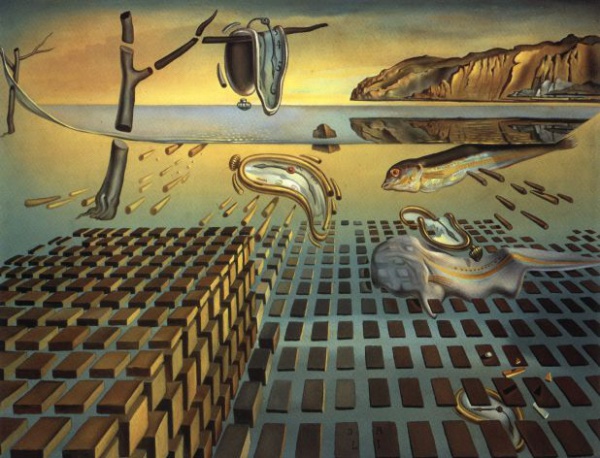Facts About The Disintegration of the Persistence of Memory
"The Disintegration of the Persistence of Memory" is an oil painting by the legendary Salvador Dalí, conceived in 1954 as a reinterpretation of his iconic 1931 masterpiece, "The Persistence of Memory." Originally bestowed with the elaborate title "The Chromosome of a Highly-coloured Fish's Eye Starting the Harmonious Disintegration of the Persistence of Memory" this compact work measures 25.4 × 33 cm and was first exhibited in New York in 1954.
In this updated version, Dalí submerges the landscape in water, crafting a captivating scene that reveals both the surface and depths of the submerged world. The familiar elements from the original painting undergo transformation: the landscape now floats above the water, and objects drift freely, symbolizing the disintegration of matter into atoms. The introduction of atomic missiles and a disintegrating dead olive tree weaves themes of destruction and transformation into the composition. Dalí's signature melting watches, along with floating conical objects and a human visage morphing into a fish, symbolize the fluidity of life.
At this time, Dalí was heavily influenced by nuclear physics, and in this painting, he endeavored to capture the essence of the quantum realm where matter manifests as both particles and waves. While the original "Persistence of Memory" subtly referenced Einstein's theory of relativity, this work delves into quantum mechanics, presenting a modern, digitized interpretation. It marks a significant shift in Dalí's career, transitioning from pure surrealism to an exploration of nuclear physics and religious themes.
Today, "The Disintegration of the Persistence of Memory" can be admired at the Salvador Dalí Museum in St. Petersburg, Florida. The painting has also been exhibited in various prestigious locations, including the National Gallery of Victoria in Melbourne in 2009.

 Mexico
Mexico